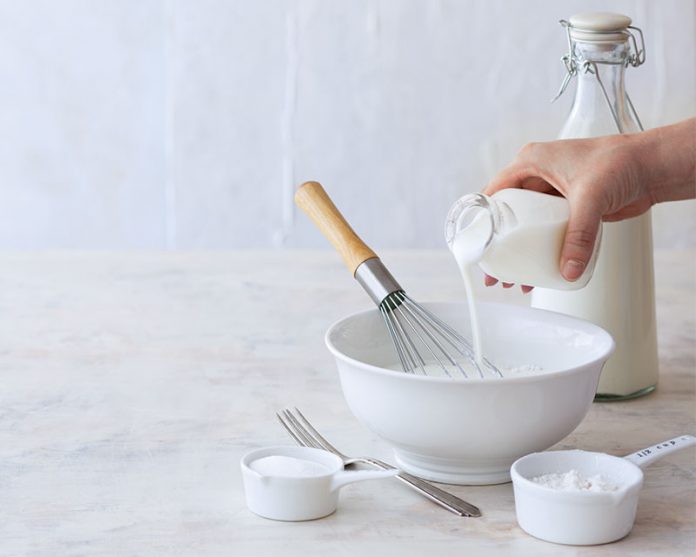
by Keia Mastrianni
This essential ingredient rises to the top. Find recipes to bake with Buttermilk in our July/August Issue, here.
The undisputed champion of tang in the baking world is none other than the versatile, wonder staple known as buttermilk. This prized liquid, traditionally what’s left after churning fresh cream into butter, gets its star power from its ability to collude with baking powder and lift biscuits to new heights. Buttermilk breaks down gluten to soften the crumb of your favorite cake, while the lactic acid and its signature zing makes pies, scones, and breads sing. Buttermilk ain’t too proud to play backup, either. It often employs subtle nuances to add depth and complexity of flavor to whatever it is added to.
What is considered buttermilk today is not what it used to be. For a better understanding, let’s look at traditional buttermilk and the butter churn before refrigeration. When fresh cream was agitated in the churn, fat globules came together to make butter, and the thin, defatted liquid left over was called buttermilk. Fresh out of the churn, the flavor is mild with faint hints of butter. But without refrigeration, a surplus of buttermilk left to the elements transforms. The thin liquid thickens as native lactic acid bacteria digests the milk sugars (lactose) to create lactic acid and that unmistakable tang of fine buttermilk. Not to be wasted, buttermilk was used in cooking applications and consumed by the glass for its nutritional benefits. Buttermilk made the old-fashioned way has probiotics that help with digestion and some claim it settles the stomach, provides energy, and brightens the skin.
Of course, this process changed over time. The commercialization of the dairy industry and regulations aimed at food safety turned a naturally cultured beverage into a mass-produced manufactured product. Most of what sits on grocery store shelves is not the weepy leftovers from the butter churn exposed to native cultures, but a deliberately cultured product crafted, many times, from sub-par product—skim or low-fat milk with added thickeners, preservatives, and stabilizers. That is to say, not all buttermilk is created equal.
The best producers begin with good product. Earl Cruze, the patriarch of Cruze Dairy Farm outside Knoxville, Tennessee, says it best, “The way you make buttermilk is the way you raise your family. You care about it 100 percent.” Look for buttermilk made from good milk with a high fat content, like the antibiotic-free Jersey cows from Cruze Dairy Farm who roam on pesticide-free pasture. Temperature and freshness count, too. Look for low-heat pasteurization, and products with no added thickeners or stabilizers. It’s important to know that even the trusted producers culture their buttermilk today. It yields a more consistent product and satisfies pesky health regulations.
One might assume buttermilk’s place is in the South. Surely it is beloved there, with well-loved images of Grandaddy crumbling a piece of cornbread into a tall glass right before bed. Endeared as it may be in the southern United States, buttermilk is used around the world. Wherever there is milk, and people making butter, there is buttermilk. In India, a buttermilk mango lassi is a refreshing reprieve on a hot day. In Ireland, fluffy pancakes and Irish soda bread make good use of fresh buttermilk. And in Scandinavia, buttermilk is baked into signature breads like Rugbrød (rye bread) and Filmjölkslimpa (cranberry seed bread), and laminated Danish. For bakers everywhere, it’s an essential ingredient—the tang heard ‘round the world.




Where is the recipe for Honey Ricotta Strudel? All I get is some article about buttermilk. Thank you.
Hey Suzanne,
Thank you for reaching out! Here is the link to the recipe for the Oversized Honey Ricotta Strudel: https://bakefromscratch.com/oversized-honey-ricotta-strudel/
Happy Baking!